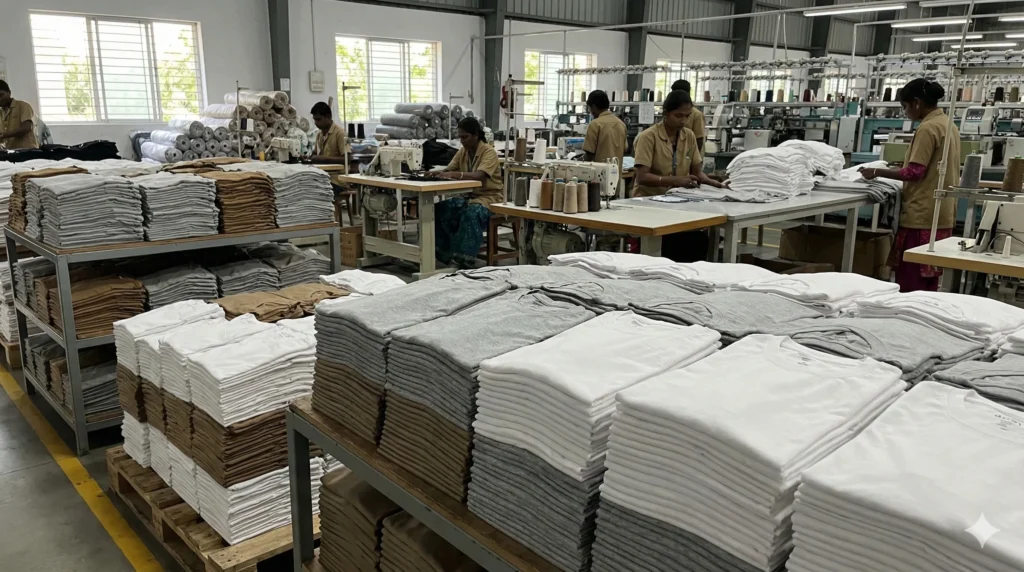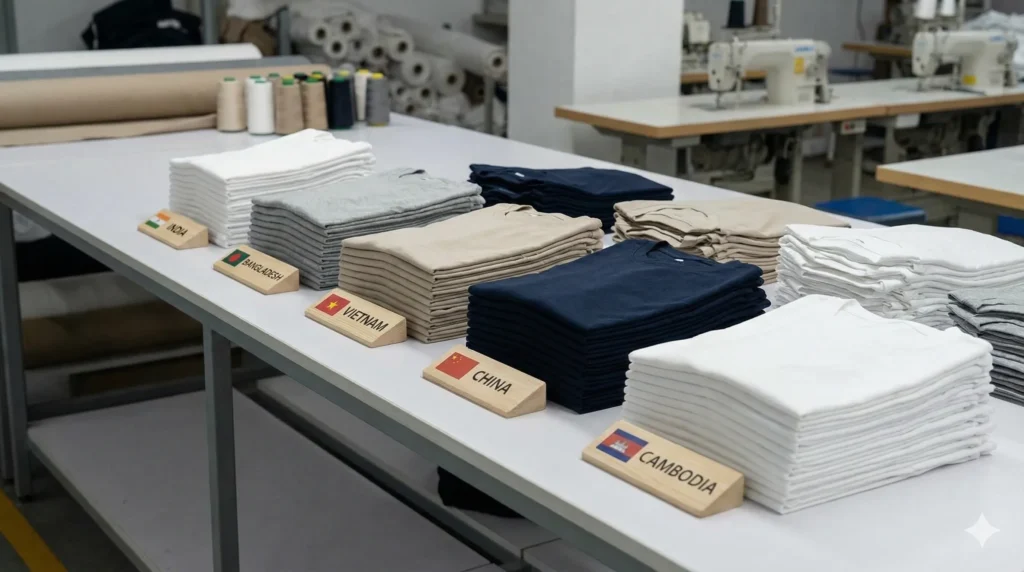Choosing the cheapest T-shirt or cotton knitwear manufacturer is never just about cost. Factors such as fabric quality, labor efficiency, infrastructure, compliance, and trade policies all play a critical role in determining the real value of sourcing. While Asia continues to dominate the global apparel supply chain, the key question remains: which country is truly the most cost-effective for T-shirt production?

Below is a practical comparison of six leading countries where global brands source T-shirts, highlighting both advantages and trade-offs.
1. India – Cost-Effective & Scalable T-Shirt Manufacturing
India offers one of the most balanced ecosystems for apparel sourcing. Tirupur, in Tamil Nadu, is globally recognised for T-shirt production, supplying everything from budget basics to premium, certified garments.
Pros
- Large, skilled workforce with deep knitwear expertise
- Strong manufacturing clusters such as Tirupur and Ludhiana
- Access to organic, recycled, and sustainable fabrics
- Export-friendly policies and improving logistics
Cons
- Regulatory paperwork can be time-consuming
- Power stability varies in smaller manufacturing hubs
- Quality standards differ across factory tiers
India successfully bridges the gap between affordability and reliability, making it ideal for brands seeking both cost-efficient T-shirt manufacturers and long-term production partners.
2. Pakistan – Low Cost but Limited Scale
Pakistan’s garment sector benefits from domestic cotton availability and competitive labor costs.
Pros
- Lower wages than many Asian counterparts
- Strong cotton supply chain
- Geographical proximity to Europe and the Middle East
Cons
- Political and economic instability
- Energy shortages affecting production continuity
- Limited scalability for large international orders
3. China – Reliable, but No Longer the Cheapest
China remains a manufacturing powerhouse, though rising costs have shifted cost-sensitive orders elsewhere.
Pros
- Advanced infrastructure and automation
- Highly efficient production systems
- Strong global logistics network
Cons
- Higher labor costs
- Trade tensions with key markets
- Less flexibility for smaller brands
4. Vietnam – Strong Trade Agreements, Growing Capacity
Vietnam has become a preferred sourcing destination due to favorable trade agreements.
Pros
- Competitive labor costs
- Access to EVFTA and CPTPP trade benefits
- Stable export environment
Cons
- Dependence on imported raw materials
- Capacity limitations compared to China or India
5. Cambodia – Very Cheap, Higher Risk
Cambodia offers some of the lowest garment manufacturing costs in Asia, but scalability remains a challenge.
Pros
- Extremely low labor costs
- Preferential EU trade access
Cons
- Weak logistics infrastructure
- Ongoing labor compliance concerns
- High sensitivity to global demand shifts
6. Bangladesh – Global Hub for Cheap T-Shirt Manufacturing
Bangladesh is among the world’s largest exporters of T-shirts and basic apparel.
Pros
- Very low production costs
- Large-scale export-ready factories
- Strong EU and US trade access
Cons
- Compliance and safety challenges in some units
- Port congestion and logistics delays
- Limited product diversification

Conclusion – Cost vs Long-Term Value
If your only objective is the cheapest possible production, Bangladesh and Cambodia lead. However, for brands that value cost control alongside quality, sustainability, and compliance, India remains the most reliable sourcing destination.
Manufacturing hubs like Tirupur combine affordability with flexibility, making India suitable for both emerging brands and established global retailers. Many buyers also prefer working with knitwear manufacturers in India due to their ability to scale responsibly.
Work With Trusted T-Shirt Manufacturers
At Synerg, we connect international buyers with verified apparel manufacturers across India, including export-ready factories supplying Europe, the UK, the USA, and Australia. Whether you are sourcing basics or premium knits, our network ensures transparent pricing, quality consistency, and compliance.
You may also find these resources useful:
For global trade benchmarks and apparel export data, refer to official statistics published by the World Trade Organization (WTO).
About the Author: The Synerg Team
Synerg Team supports global buyers by working with export-ready apparel and Ready made garment manufacturers in India, with a strong focus on cost planning, compliance, and bulk production execution for knitwear categories like T-shirts.
Want help shortlisting the right factory by price, quality, and compliance?
Contact the Synerg team
.

